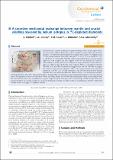Files in this item
A secretive mechanical exchange between mantle and crustal volatiles revealed by helium isotopes in 13C-depleted diamonds
Item metadata
| dc.contributor.author | Mikhail, Sami | |
| dc.contributor.author | Crosby, James | |
| dc.contributor.author | Stuart, Fin | |
| dc.contributor.author | DiNicola, L | |
| dc.contributor.author | Abernethy, F. A. J. | |
| dc.date.accessioned | 2019-10-10T16:30:06Z | |
| dc.date.available | 2019-10-10T16:30:06Z | |
| dc.date.issued | 2019-10-10 | |
| dc.identifier | 261712663 | |
| dc.identifier | 77858074-d951-4499-a2a5-349fbebd491d | |
| dc.identifier | 000489611200001 | |
| dc.identifier | 85105082682 | |
| dc.identifier.citation | Mikhail , S , Crosby , J , Stuart , F , DiNicola , L & Abernethy , F A J 2019 , ' A secretive mechanical exchange between mantle and crustal volatiles revealed by helium isotopes in 13 C-depleted diamonds ' , Geochemical Perspectives Letters , vol. 11 , pp. 39-43 . https://doi.org/10.7185/geochemlet.1923 | en |
| dc.identifier.issn | 2410-339X | |
| dc.identifier.other | ORCID: /0000-0001-5276-0229/work/63046005 | |
| dc.identifier.uri | https://hdl.handle.net/10023/18642 | |
| dc.description | SM acknowledges support from the National Environmental Research Council (grant no. NE/PO12167/1). | en |
| dc.description.abstract | Fluid inclusions trapped in fast-growing diamonds provide a unique opportunity to examine the origin of diamonds, and the conditions under which they formed. Eclogitic to websteritic diamondites from southern Africa show 13C-depletion and 15N-enrichment relative to mantle values (δ13C = -4.3 to -22.2 ‰ and δ15N = -4.9 to +23.2 ‰). In contrast the 3He/4He of the trapped fluids have a strong mantle signature, one sample has the highest value so far recorded for African diamonds (8.5 ± 0.4 Ra). We find no evidence for deep mantle He in these diamondites, or indeed in any diamonds from southern Africa. A correlation between 3He/4He ratios and 3He concentration suggests that the low 3He/4He are largely the result of ingrowth of radiogenic 4He in the trapped fluids since diamond formation. The He-C-N isotope systematics can be best described by mixing between fluid released from subducted altered oceanic crust and mantle volatiles. The high 3He/4He of low δ13C diamondites reflects the high 3He concentration in the mantle fluids relative to the slab-derived fluids. The presence of post-crystallisation 4He in the fluids means that all 3He/4He are minima, which in turn implies that the slab-derived carbon has a sedimentary organic origin. In short, although carbon and nitrogen stable isotope data show strong evidence for crustal sources for diamond-formation, helium isotopes reveal an unambiguous mantle component hidden within a strongly 13C-depleted system. | |
| dc.format.extent | 2336762 | |
| dc.language.iso | eng | |
| dc.relation.ispartof | Geochemical Perspectives Letters | en |
| dc.subject | Diamond | en |
| dc.subject | Volatiles | en |
| dc.subject | Nobel gases | en |
| dc.subject | Stable isotopes | en |
| dc.subject | Deep carbon cycle | en |
| dc.subject | GE Environmental Sciences | en |
| dc.subject | QE Geology | en |
| dc.subject | QD Chemistry | en |
| dc.subject | NDAS | en |
| dc.subject.lcc | GE | en |
| dc.subject.lcc | QE | en |
| dc.subject.lcc | QD | en |
| dc.title | A secretive mechanical exchange between mantle and crustal volatiles revealed by helium isotopes in 13C-depleted diamonds | en |
| dc.type | Journal article | en |
| dc.contributor.sponsor | NERC | en |
| dc.contributor.institution | University of St Andrews. School of Earth & Environmental Sciences | en |
| dc.contributor.institution | University of St Andrews. St Andrews Centre for Exoplanet Science | en |
| dc.contributor.institution | University of St Andrews. St Andrews Isotope Geochemistry | en |
| dc.identifier.doi | 10.7185/geochemlet.1923 | |
| dc.description.status | Peer reviewed | en |
| dc.identifier.grantnumber | NE/P012167/1 | en |
This item appears in the following Collection(s)
Items in the St Andrews Research Repository are protected by copyright, with all rights reserved, unless otherwise indicated.

